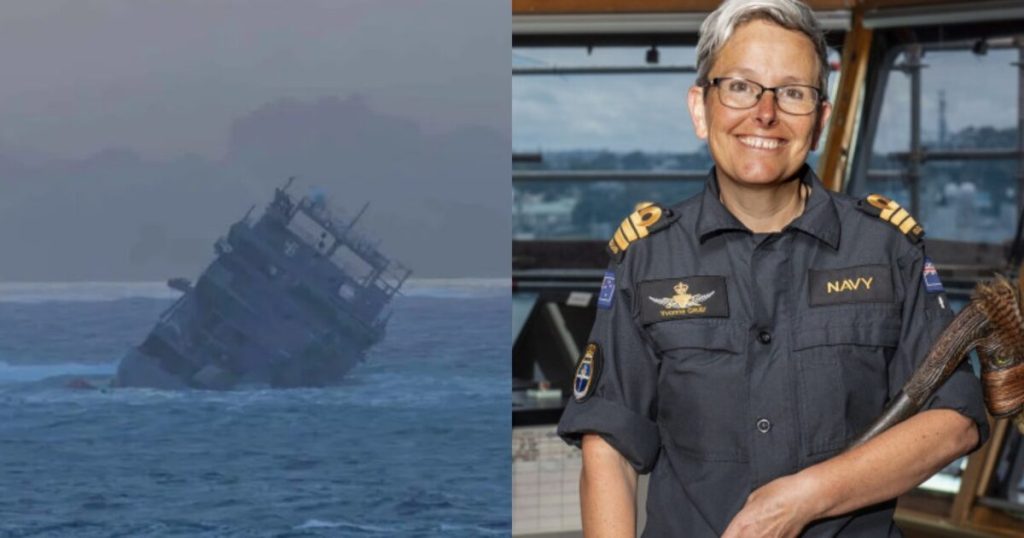New Zealand Navy ship caught fire and sank in the Pacific Ocean
New Zealand’s navy has suffered its first peacetime ship loss since World War II when the $100 million multi-role support vessel HMNZS Manawanui ran aground off the southern coast of Upolu Island, Samoa, caught fire and eventually sank—triggering an environmental disaster in the process.
With all 75 passengers and crew evacuated, the vessel’s loss brings fresh scrutiny to the leadership under its openly lesbian commanding officer, Commander Yvonne Gray.
The Manawanui, originally built in Norway and repurposed for New Zealand’s Royal Navy with a substantial $103 million investment, was conducting a seabed survey mission when it hit a reef, according to maritime news outlet gCaptain.
WATCH:
Another consequence of DEI hiring initiatives?
NZ Navy’s HMNZS Manawanui has run aground off the coast of Samoa during a reef survey. All 75 crew and passengers safely evacuated, but the vessel caught fire and has sunk. Rescue operations were conducted by Samoan emergency… pic.twitter.com/TqyOJACZWv
— The Based Dude (@thebaseddude) October 5, 2024
Onboard were not only sailors but also civilian scientists and foreign personnel.
During a high-stakes nighttime evacuation, the crew was forced to abandon ship under perilous conditions, with life rafts tossed in violent seas and some occupants scrambling to reach shore through rough waters.
Three crew members required medical attention, with one for a dislocated shoulder and another for a back injury.
Samoan fire rescue team responded to the Manawanui vessel navy crew in distress. (Credit: Samoa Fire and Emergency Services Authority)
One injured navy crew (Credit: Samoa Fire and Emergency Services Authority)
gCaptain reported:
Videos and photos published by local media showed the Manawanui listing heavily and on fire with plumes of thick grey smoke rising after it ran aground. By 9 a.m. local time, the vessel had capsized and was “now submerged” after sinking beneath the surface, according to Reuters.
The New Zealand Defence Force stated that the cause of the grounding is currently unknown and will require further investigation. The ship was on its third deployment to the South West Pacific this year, with scheduled activities in the Kermadec Islands, Samoa, Tokelau, and Niue. It was due to return home on November 1st. The crew included seven civilian scientists and four foreigners.
The incident unfolded on Saturday evening, leading to a complex nighttime evacuation of all 75 crew members and passengers in challenging weather conditions. While New Zealand officials are praising the ship’s commanding officer, Commander Yvonne Gray, for her swift action, some question whether more could have been done to save one of only five fully operational ships in the underfunded and overworked RNZN fleet.
“Evacuating a ship at night is an incredibly complicated and difficult task,” remarked Maritime Component Commander Commodore Garin Golding. The crew began abandoning ship at 7:52 p.m., deploying into lifeboats amid challenging sea conditions. Rescuers battled strong currents and winds that pushed life rafts toward dangerous reefs, while swells added to the peril. The first sailor was rescued at 1 a.m. with the last recovered at 5:30 a.m. local time.
Most personnel were transferred from life rafts onto rescue vessels. However, one small raft capsized on a reef, forcing its occupants to wade to land. Despite the harrowing circumstances, injuries were minimal: two individuals were sent to the hospital—one for a dislocated shoulder and another for a back injury—while 12 to 15 others suffered minor cuts and abrasions.
Commander Yvonne Gray (Credit: New Zealand Defense Force)
Commander Gray, formerly a teacher from Yorkshire, England, took command of the vessel just last year. Her appointment marked another milestone in the Navy’s diversity agenda, but critics argue that such priorities may have overshadowed critical operational readiness.
Commodore Garin Golding praised Gray’s leadership, citing the complexity of a nighttime evacuation, but the incident has sparked debates on whether this “diversity-first” approach compromised the Navy’s standards.
According to the press release in 2022:
Harrogate-born Yvonne Gray trained as a teacher and once hoped to open her own restaurant. Instead she said she found her perfect niche as a naval officer, first in the Royal Navy and now in the Pacific with the Royal New Zealand Navy (RNZN).
Today, Commander Gray took the helm of the RNZN’s dive, hydrographic and salvage vessel HMNZS Manawanui, based at Devonport Naval Base in Auckland. Manawanui is Māori for ‘steadfast’ or ‘big heart’.
It is her first ship command in a naval career that started in the United Kingdom in 1993 as a warfare officer. Her service as a warfare officer ranged from working on aircraft carriers to frigates and mine hunters.
In 2012, Commander Gray and her wife Sharon moved to New Zealand after falling in love with the country during a campervan holiday.
“The most obvious thing to do was join the Royal New Zealand Navy,” she said.
The post New Zealand’s Lesbian Navy Captain Loses $100M Naval Ship in Peacetime Disaster – Ship Runs Aground, Catches Fire, and Sinks, Unleashing Oil Spill off Samoa Coast appeared first on The Gateway Pundit.







